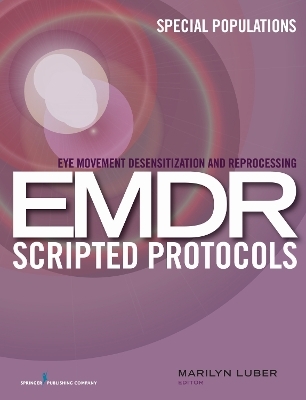
Eye Movement Desensitization and Reprocessing (EMDR) Scripted Protocols
Springer Publishing Co Inc (Verlag)
978-0-8261-2239-1 (ISBN)
"This excellent book contains many different scripts, applicable to a number of special populations. It takes a practical approach and walks therapists step-by-step through the EMDR therapeutic process. [Readers] will not be disappointed." Score:93, 4 stars
-Doody's
Praise from a practicing EMDR therapist and user of Eye Movement Desensitization and Reprocessing (EMDR) Scripted Protocols:
Kudos to...everyone who contributed to this important volume....[It] is an indispensable resource. Thank you, thank you, thank you!"
--Andrea B. Goldberg, LCSW
EMDRIA Certified EMDR Therapist
EMDRIA Consultant-in-training
This book outlines some of the basic elements of the 11-Step Standard Procedure of EMDR and the Standard Three-Pronged EMDR Protocol. Unlike other EMDR books, however, this book focuses on applying EMDR scripted protocols to special populations.
Special populations discussed include children, adolescents, couples, and clients suffering from complex posttraumatic stress disorder, dissociative disorders, anxiety, addictive behaviors, and severe pain. This is a volume rich in wisdom and insight that every EMDR clinician working with special populations will need in his or her collection.
Key topics include:
EMDR preparation, assessment, and desensitization phases for children
Integrating EMDR into couples therapy
EMDR protocol for treating sexual dysfunction
EMDR-informed treatment approaches for dissociative disorders
Clearing the pain of unrequited love with EMDR
An EMDR approach to treating substance abuse and addiction
EMDR for pain patients
Self-care for EMDR practitioners
Marilyn Luber, PhD, is a licensed, clinical psychologist in private practice in Philadelphia. She was on the Founding Board of Directors of EMDRIA and an EMDR Task Force for Dissociative Disorders member. She has conducted training both nationally and internationally. She is a co-facilitator for the EMDR Global Alliance. She is on the Steering Committee for the Future of EMDR Therapy Project, on the Council of Scholars, and chair of the "What is EMDR" working group. She received HAP's Humanitarian Services Award (1997), Outstanding Contribution to EMDRIA award (2003) and EMDRIA's Francine Shapiro Award (2005).
Part I: EMDR with Children and Adolescents
Chapter 1 The Butterfly Hug
Chapter 2 Using Olfactory Stimulation with Children to Cue the Safe or Happy Place
.Chapter 3 Using Olfactory Stimulation with Children to Cue Resource Development and Installation (RDI)
Chapter 4 Resource Connection for Children
Chapter 5 The Absorption Technique for Children
Chapter 6 The Method of Constant Installation of Present Orientation and Safety (CIPOS) for Children
Chapter 7 Footsteps Through the Maze
Chapter 8 EMDR Assessment and Desensitization Phases with Children: Step-by- Step Session Directions
Part II: EMDR and Couples
Chapter 9 Integrating EMDR into Couples Therapy
Chapter 10 From Relational Problems to Psychological Solutions: EMDR in Couples Therapy
Chapter 11 EMDR Protocol for Treating Sexual Dysfunction
Chapter 12 Infertility Protocol with EMDR
Part III: EMDR, Dissociative Disorders and Complex Posttraumatic Stress Disorder
Chapter 13 Stabilization Phase of Trauma Treatment: Introducing and Accessing the Ego State System
Chapter 14 Home Base
Chapter 15 Workplace or Conference Room
Chapter 16 Orienting the Ego State System to Present Reality (OPR)
Chapter 17 Back of the Head Scale (BHS)
Chapter 18 The Method of Constant Installation of Present Orientation and Safety (CIPOS)
Chapter 19 Installation and Transmission of Current Time and Life Orientation
Chapter 20 Height Orientation
Chapter 21 Safe Space Imagery (SSI)
Chapter 22 Installing Therapist and Therapist's Office,
and Maintaining Duality
Chapter 23 The Absorption Technique
Chapter 24 Modified Resource Development and
Installation (RDI) Procedures with Dissociative Clients
Chapter 25 Constructive Avoidance of Present Day Situations: Techniques for Managing Critical Life Issues
Chapter 26 Initial Targeting of Traumatic Material: Steps
Chapter 27 The Inverted EMDR Standard Protocol for Unstable Complex Posttraumatic Stress Disorder
Chapter 28 The Wreathing Protocol: The Imbrication of Hypnosis and EMDR in the Treatment of Dissociative Identity Disorder, Dissociative Disorder NOS and Posttraumatic Stress Disorder
Chapter 29 The "Bottom.-.Up Processing" Protocol
Chapter 30 ACT-AS-IF and ARCHITECTS Approaches to EMDR Treatment of DID
Chapter 31 An EMDR Protocol for Dissociative Identity Disorder (DID)
Chapter 32 Protocol for Releasing Stuck Negative Cognitions in Childhood Onset - Complex PTSD
Part IV: EMDR and Clients with Addictive Behaviors
Chapter 33 Dysfunctional Positive Affect: To Assist Clients with Unwanted Avoidance Defenses
Chapter 34 Dysfunctional Positive Affect: Procrastination
Chapter 35 Dysfunctional Positive Affect: To Clear the Pain of Unrequited Love
Chapter 36 Dysfunctional Positive Affect: Codependence/Obsession with Self-Defeating Behavior
Chapter 37 CravEx: An EMDR Approach to Treat
Substance Abuse and Addiction
Chapter 38 The Desensitization of Triggers and Urge Reprocessing (DeTUR) Protocol
Part V: EMDR and Clients with Pain
Chapter 39 Pain Control with EMDR
Chapter 40 EMDR Pain Protocol for Current Pain
Chapter 41 EMDR and Phantom Pain Research Protocol
Part VI: EMDR and Specific Fears
Chapter 42 EMDR and Specific Fears: The Phobia Protocol Single Traumatic Event
Part VII: EMDR and Clinician Self-Care
Chapter 43 Self-Care for EMDR Practitioners
Chapter 44 The Clinician Self - Awareness Questionnaire in EMDR
Appendix A: Worksheets
Past Memory Worksheet Scripts (Shapiro, 2001, 2006)
Present Trigger Worksheet Script
Future Template Worksheet (Shapiro, 2006)
Appendix B: Expanding the 11-step Procedure
Unconsolidated Sensory Triggers and Desensitization: Running the Tape
Script for Running the Tape to Identify and Process Unconsolidated Sensory -Triggers
Appendix C: Resources
References
Further Readings and Presentations
Index
| Zusatzinfo | 6 illustrations; 6 Illustrations |
|---|---|
| Verlagsort | New York |
| Sprache | englisch |
| Maße | 216 x 279 mm |
| Gewicht | 1647 g |
| Themenwelt | Geisteswissenschaften ► Psychologie ► Test in der Psychologie |
| Medizin / Pharmazie ► Medizinische Fachgebiete ► Neurologie | |
| Medizin / Pharmazie ► Medizinische Fachgebiete ► Psychiatrie / Psychotherapie | |
| ISBN-10 | 0-8261-2239-6 / 0826122396 |
| ISBN-13 | 978-0-8261-2239-1 / 9780826122391 |
| Zustand | Neuware |
| Haben Sie eine Frage zum Produkt? |
aus dem Bereich


